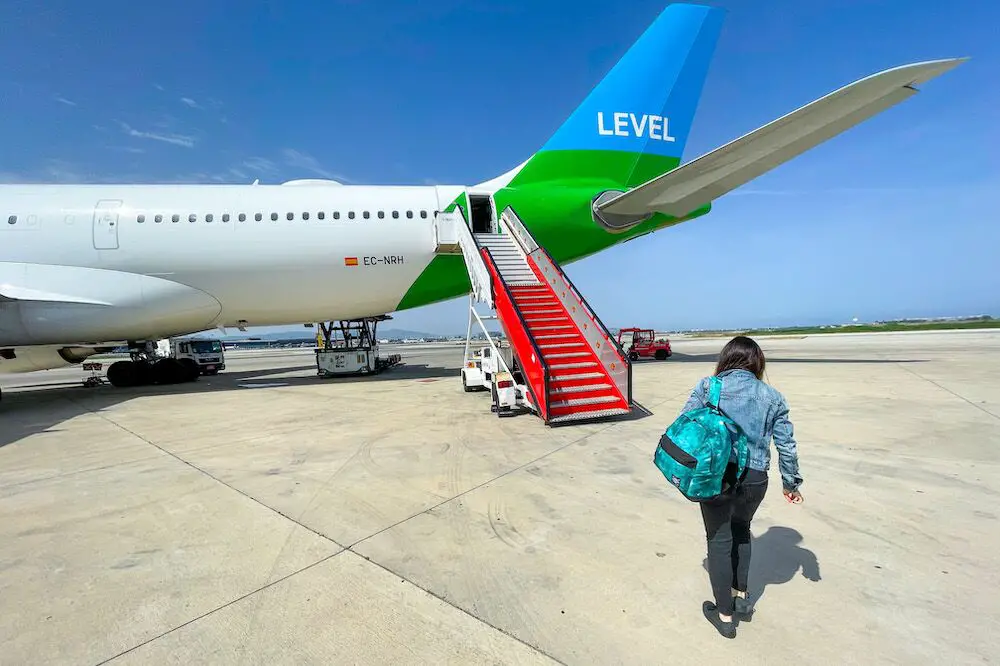When it comes to traveling on a budget, taking connecting flights with budget airlines can significantly lower your costs.
However, these connecting flights may come with their own set of struggles and challenges. It’s essential to understand how these flights work to ensure that you arrive at your destination without any hiccups. In this post, we will discuss everything you need to know about connecting flights with low cost airlines, including the types of connecting flights, connecting flights vs self-transfer flights, and tips to make the process smoother.
Did you miss a connecting flight? File a compensation claim online.

1. What Is a Budget Airline?
Budget airlines are also called low cost airlines.
They offer flights at cheaper prices than regular airlines. They might have fewer amenities or services, but they help you save money on your trip.
The main difference between a traditional airline and a low cost airline is the price. Traditional airlines usually offer more services, amenities, flights options and routes than low cost carriers which can make them a slightly pricier option but more convenient for passengers. Budget airlines generally offer fewer services on flights, such as meals or seat selection, but they are often cheaper than traditional airlines.
Low cost carriers also operate differently: they typically have fewer staff per passenger and focus on direct point-to-point routes instead of connecting flights. Nevertheless, some budget airlines do provide connecting flights.
2. Connecting Flights with Budget Airlines: Types
When booking a connecting flight with a budget airline, there are two types of connections you can make, point-to-point and hub connections.
However, not all budget airlines offer both flight types. Ryanair and Wizz Air are examples of budget airlines that only provide point-to-point connections, while Vueling offers both hub and point-to-point connections.
Let’s dive in and learn more about connecting flights with budget airlines!
2.1 Hub Connections: Protected Connecting Flights
Hub connections require booking through a central hub airport where all flights are connected from that hub. Such connections are often offered by the airline itself, and these connecting flights are classified as “airline-protected connecting flights”.
You are protected in case of missed connections, and your baggage will be transferred for you. Vueling and Norwegian are two of the most popular budget airlines that offer this kind of connecting flights.
Some budget airlines offer connections operated by partner airlines. Here’s how it works: when booking a connecting flight, your budget airline partners with another airline for the second leg of the journey. This guarantees that if there is a delay or cancellation on the initial flight, the partner airline will transport you to the next available flight without additional fees.
Your checked baggage may be automatically transferred to the connecting flight, removing the need to collect and recheck it (however, not all budget airline partnerships make this possible).
In most cases, connecting flights with budget airlines work just like connecting flights with full-service airlines.
2.2 Point-To-Point: Self-Transfer Flights
A point-to-point flight is a type of flight where the airline operates direct routes between two airports, without any stopovers or connections. In other words, the flight takes off from one airport and lands at another airport without stopping anywhere in between.
Point-to-point flights are common among budget airlines as they can reduce costs by avoiding the need for a hub airport and additional services required for connecting flights.
If hub connections are not offered, the only way to plan a connection, is to book a self-transfer flight. This means you are booking two or more point-to-point flights separately and planning a connection yourself.
Many travelers prefer to book self-transfer flights that involve various low-cost airlines. These connections typically provide greater flexibility and cost savings on airfare.
If you’re booking a self-transfer flight that involves multiple airlines, it’s important to take note of the airport codes. It’s possible that various airlines operate from different airports, and in certain cities, the distance between them can be significant. It’s safer to avoid flights that necessitate a change in airports unless it’s a lengthy, multi-hour layover.
Also keep in mind that you have to collect and recheck your baggage after every flight, even if you have multiple flights with the same airline. Since you’ve booked a self-transfer flight, the airline is not responsible for transferring your baggage.
Read more: Baggage on Connecting Flights

3. Missed Connecting Flight Due to Delay or Cancellation
If you miss a connecting flight, what happens?
Missing a connecting flight is not fun. But it’s also not as scary as it sounds. Especially, if you are protected by airline.
If you have an airline-protected connecting flight, you don’t have to worry about it. The airline will arrange for you to be transferred to their next available flight to your final destination. If that next flight is only available the following day, and you need to spend a night at the airport, the airline will provide complimentary meals, accommodation, and transportation to and from the hotel.
However, if you’ve booked a self-transfer flight (consisting of several point-to-point flights), airlines aren’t responsible if you miss your final flight, even if it’s not your fault. A self-transfer implies that you’re responsible for finding a solution if you miss a flight or several.
4. Tips for Connecting Flights with Budget Airlines
Here are some great connecting flight tips for a smoother experience.
- Book flights with ample time (2-3 hours) between them, to allow for unexpected delays and long lines at security. It’s especially important if you have a self-transfer flight (multiple point-to-point flights). You’ll need plenty of time for collecting your bag, going through immigration, checking in for your next flight and going through security.
- Read the airline’s policy regarding baggage fees, as most budget airlines have strict baggage allowances. Especially if you have 2 or more flights with different budget airlines.
- Prior to your journey, it’s advisable to research the layout of the connecting airport and familiarize yourself with it. Navigating large airports may be tedious and complicated, so understanding where your departure gate is located and identifying the most convenient route to reach there can save you time. Most airports offer terminal maps on their websites or mobile applications for passengers’ convenience.
- Book accommodation nearest to the airport if you have a long layover to save on transportation costs.
- Avoid booking self-transfer if you have a tight connection or if you are not familiar with the airport’s procedures.
- Book a protected connecting flight. It provides additional security in the event of delays or cancellations, as the airline assumes responsibility for rebooking you on the next available flight at no extra cost.
- Check visa and immigration requirements. If you have a connection in a different country, verify whether you need a visa for your connecting flight. Ensure you meet all the necessary requirements to avoid any issues during your journey.
5. Choosing the Right Budget Airline
Different budget airlines have different policies.
That’s why it’s crucial to research the airline’s policies before booking a connecting flight. For example, Norwegian is inexpensive, and offers connecting flights due to its hub and spoke network.
Ryanair, on the other hand, doesn’t offer connecting flights, as it operates on a point-to-point model. If you want to book a connecting flight with Ryanair, you have to book separate flights. As each of these flights are booked separately, it’s considered to be a self-transfer flight, and is not protected by the airline. As you might already know, self-transfer flights are not as safe as connecting flights.
Several other large budget airlines fly in a point to-point model. The most popular ones are Wizz Air and easyJet.
Do you have more questions about connecting flights with budget airlines or self transfers with budget airlines? Ask in the comments or read our guide to connecting flights.
About the author:
Kaspars is a digital nomad and travel blogger who’s been traveling the world extensively since 2013. Since 2017, Kaspars has been writing about the less-known aspects of air travel, things like air passenger rights laws and regulations. He’s really good at simplifying complex concepts and making them easily understandable. Kaspars favorite airlines are Qatar Airways and Turkish Airlines.
